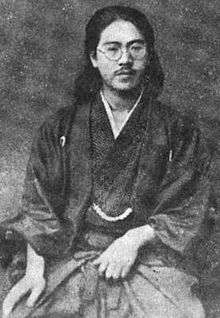Seiko Fujita
Seiko Fujita (藤田 西湖, Fujita Seiko, February 10, 1898 – January 4, 1966), born Isamu Fujita (藤田 勇, Fujita Isamu), was a prominent Japanese martial artist, researcher and author. Regarded as the 14th and final heir to the Kōga-ryū Wada-ha Ninjutsu tradition, he was highly respected by his peers and a core member of Japan's classical martial arts community. [1]
| Seiko Fujita | |
|---|---|
 | |
| Born | Isamu Fujita February 10, 1898 Tokyo, Japan |
| Died | January 4, 1966 (aged 67) Liver cirrhosis |
| Style | Kōga-ryū Ninjutsu
Shingetsu-ryū Shurikenjutsu Nanban Sattō-ryū Kenpō |
| Notable students | Iwata Manzo Inoue Motokatsu Saitō Satoshi Mabuni Kenei Ueda Isamu |
Biography
Isamu Fujita was born in Tokyo, and studied Kōga-ryū Wada-ha (Ninjutsu) under the tutelage of his grandfather, Fujita Shintazaemon, 13th Soke of the Wada branch of Kōga-ryū Ninjutsu. He was educated at both Waseda and Meiji universities, and initially began his career at a newspaper company. He went on to study several other martial arts and was also noted as an author, researcher and collector of ancient scrolls. According to some references, "opinions are divided if he was a real ninja or a mere budō researcher."[2]
During World War II, Fujita taught Koga Ryu Ninjutsu in the Army Academy of Nakano (Rikugun Nakano Gakkō). Fujita later worked as a government security specialist. In later years he was influential in teaching many traditional Japanese arts. Notable students include Motokatsu Inoue, Mabuni Kenwa, Fujitani Masatoshi, actor Tomisaburo Wakayama and Manzo Iwata, who became heir to some of his styles. Fujita left no heir for Kōga-ryū Wada Ha.
Seiko Fujita published Zukai Torinawajutsu showing hundreds of Hojōjutsu ties from many different schools, and several other texts on ninjutsu and martial arts. He died of cirrhosis of the liver at about the age of 68 and likely suffered from hereditary angioedema (which can preclude the practice of martial arts, although Fujita may have demonstrated the ability to overcome some disease symptoms).[3] His collection, the Fujita Seiko Bunko, is housed at Iga-Ueno Museum, Odawara Castle.[4]
Bibliography of the main works
Title in Japanese kanji / Transcription of the Japanese title with occidental alphabet / Translation of the Japanese title / Year of publication
- 法術行り方繪解 (in Japanese). 1928. "Hôjutsu yarikata zukai", "Illustrated guidance of Budo tricks" ;
- 忍術秘録 (in Japanese). 千代天書. 1936. "Ninjutsu hiroku", "Secrets notes about ninjutsu" ;
- 忍術とは? (in Japanese). 1938. "Ninjutsu to wa?", "What is Ninjutsu" ;
Translated into English in 2017 by Eric Shahan.
- 忍術からスパイ戦へ (in Japanese). 1942. « Ninjutsu kara spy sen he » « From ninjutsu to spy warfare »
- 神道夢想流杖術図解 (in Japanese). 1953. "Shindô Musô Ryû Jôjutsu Zukai", "The illustrated technique of the heavenly way of the short staff from the Musô's School »
- どろんろん最後の忍者 (in Japanese). October 1958. "Doronron : Saigo no Ninja", "The last ninja"
- 拳法極意當身殺活法明解 (in Japanese). 1958., "Kenpô Gokui Atemi Sappô Kappô Meikai", "The technique of strike the vital points from the Kenpō for kill or revive"
In 1972, a big part of this book has been translated in French by Jacques Devêvre, and published by the editions « Judo international », with the title : « Les points vitaux secrets du corps humain » (« The secret vital points of the human body »), then re-published in 1998, by « Budo editions », with the title : « L’art ultime et sublime des points vitaux » (« The magnificent and ultimate art of the vital points ») (with commentaries by Henry Plée)
- 図解 手裏剣術 (in Japanese). June 1964. "Zukai Shurikenjutsu", "The illustrated technique of the shuriken"
- 図解 捕縄術 (in Japanese). Autumn 1964. "Zukai Hojōjutsu" / "Zukai Torinawajutsu", "The illustrated technique of the binding rope"
References
- Draeger, Donn F.; Smith, Robert W. (1980). Comprehensive Asian fighting arts. Kodansha International. pp. 130–131. Retrieved April 18, 2012.
- "Fujita Seiko (1899-1966) | Martial Antiques". Ryukyu-bugei.com. April 9, 2011. Retrieved January 18, 2014.
- Ashrafian, Hutan. (2005). "Hereditary angioedema in a martial arts family". Clin J Sport Med. 15: 277–8. doi:10.1097/01.jsm.0000171884.12174.6a.
- "Fujita Seiko (Isamu Fujita) – The Last Koga Ninja". Retrieved April 18, 2012.
Further reading
- Fujita Seiko:: The Last Koga Ninja by Phillip T. Hevener (19 February 2008) ISBN 978-1436301763
- What is Ninjutsu? by Fujita Seiko (English translation) (21 January 2017) ISBN 978-1541060005